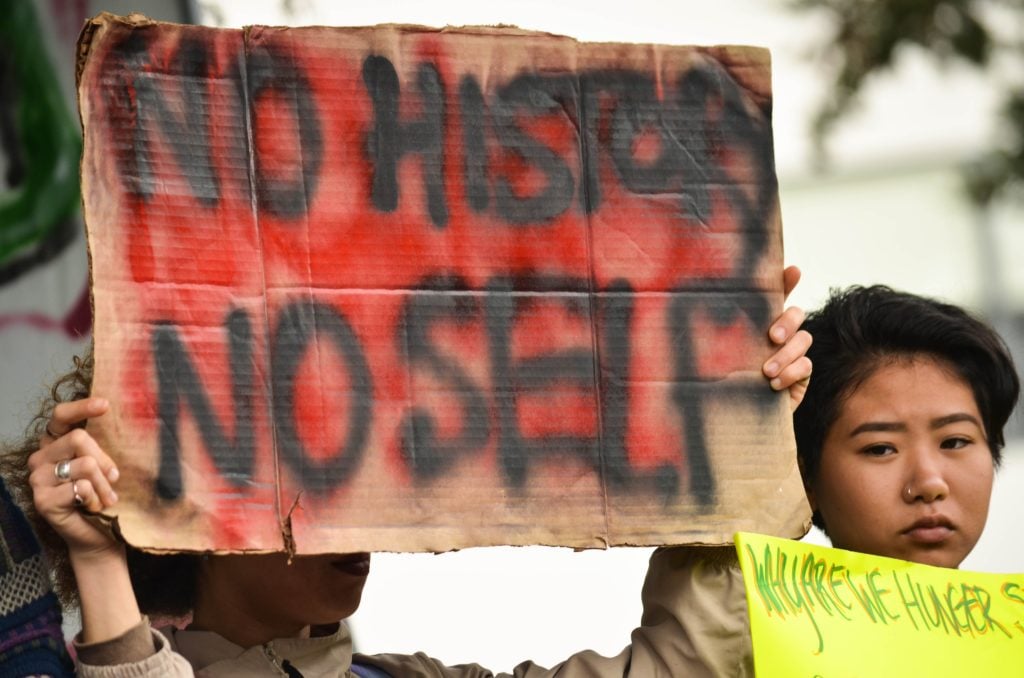Despite the amnesia induced by the 24-hour news cycle, the right wing’s assault on Critical Race Theory (CRT) is best understood as the latest in a series of propaganda campaigns from the U.S. to Germany to Argentina, all promoting the idea that the country is full of and threatened by dangerous, internal enemies. The danger it poses is greater than that of erasing history — it is literally lethal.
Critical Race Theory is a varied and complex set of academic discourses that are too much to detail in this piece, not the least because they have been better and more fully explained here and here, for example. In short, CRT is a shorthand referring to ways of thinking about our past and present that adequately account for the relationship between race and the structure of our society. CRT and its practitioners seek to reveal the structural racism inherent in the founding and functioning of the U.S. and other white settler colonial societies. They do this through work as historians, educators, and organizers, ensuring not only that we reckon with our racist past and present but that we build an antiracist future.
For the right wing, though, this perspective is nothing but unpatriotic poison. Media outlets from Fox News to popular Youtubers to memes present CRT as a kind of disease eating away at the heart of the U.S,. teaching children to hate their country and heritage. The problems with this perspective are obvious — it assumes a white audience, it erases basic facts about U.S. history, etc.
More ominously still, the attacks represent propaganda of a specific type, with a specific and storied past. Critics are scapegoating CRT and anyone they can associate it with to justify their efforts to, as they understand it, take their country back from those who took it from them. This kind of propaganda, and the narrative it promotes, has a name — the “stab in the back myth.”
The stab in the back
The “stab in the back” is the phrase the Nazi movement used to explain why their country lost World War I. In short, it claims that Germany would have won the war were it not for its being undermined from within by internal enemies of not just the German state but the German people. In other words, Germany lost not due to the efforts of its enemies but from a lack of internal resolve and the machinations of certain Germans who, the story goes, wanted their country to lose.
This propaganda served the Nazis in two important ways. First, it allowed them to frame the German military as the heroes of the war rather than as those responsible for their country’s economic and political turmoil. Protecting the military’s image was vital not only because many early Nazis were WWI veterans, but because they hoped to have the military on their side after their takeover of the country. The second, possibly even more important, function of the “stab in the back” myth was that it deflected blame for Germany’s loss onto those who were already their primary domestic enemies — politically, the Marxist left, and socially those whom the Nazis considered to be lesser humans, such as homosexuals, the differently abled, and people of Jewish, Roma, and Slavic descent.
This myth was at the heart of Nazi ideology and played a major role in many propaganda campaigns, often referenced directly as an explanation for Germany’s recent past. Still, it was far more than content for speeches and films. It was a central logic of the regime, justifying its crimes and shunting off blame for any failures. It legitimized the Gestapo’s reign of terror, encouraging people to spy on and report on their neighbors. It even justified a major purge within the Nazi party itself, the Night of the Long Knives, in which Hitler’s main rivals for power in the party organization were rounded up and executed, blamed for the internal decay and corruption brought by the party’s electoral success.
The “stab in the back” myth isn’t just a feature of Nazi ideology, however — it has played a similar and major role in right-wing political movements throughout modern history. Examples range from the Dreyfus Affair in late 19th century France, in which a Jewish officer became a scapegoat for the country’s recent military loss to the Prussians, to the Guerra Sucia (Dirty War) in Argentina from 1976 – 1983 and similar conflicts elsewhere in Latin America, in which leftists, unionists, and journalists were held responsible for the country’s previous decades of political strife.
This kind of propaganda appears essentially any time that the right wing needs to blame anyone but the powerful for a recent political or military failure, and the U.S. is no exception. One can see this logic clearly in right-wing discourse from the U.S. loss in Vietnam — “we would’ve won if our hands weren’t tied behind our back by Washington” or “if it weren’t for hippies wanting peace instead of victory” — to John Bolton’s recent statements about the complete withdrawal of U.S. forces from Afghanistan.
Baked-in anti-semitism
Though their content varies, the form and function of these arguments is the same. Their purpose is to encourage people to blame the downtrodden and oppressed for their society’s woes, rather than those in power, and to justify violent retaliation against the Left to prevent it from organizing successfully.
Another connection among all these perspectives is their inherent anti-Semitism. In some cases, this is explicit. The most famous of these is, of course, Nazi Germany, where the “stab in the back” myth combined with centuries of anti-Semitic ideology to justify mass murder of Jewish and other minorities throughout Germany and the rest of Europe. While not as overtly anti-Semitic as the Nazi case, the Argentine dictatorship was also deeply anti-Semitic and disproportionately killed and imprisoned people of Jewish descent.
Arguably, this is the central content of anti-Semitism as a form of right-wing ideology — it promotes the idea that the country is full of invisible, internal enemies, who might at any time be “mistaken” for being normal and deserving members of society. The essential question is “who belongs?” The Nazis, like generations of anti-Semites in Germany before them, claimed that Jewish people and dozens of other social and ethnic groups didn’t. This rejection led them to demand first their exclusion from society and finally their mass murder. But while this logic — of the identification, exclusion, and persecution of an internal enemy — is historically associated with the persecution of Jewish people, it can be and often is directed at other minority or oppressed groups. In many ways it is at the heart of the structural evils which progressives and the left fight against.
In bringing anti-Semitism into the conversation on the right-wing’s assault on CRT I am not trying to facilely compare anti-Blackness and anti-Semitism, nor to imply that the Nazi mass murder campaigns are comparable to the history of enslavement. Anti-Blackness in the U.S. has its roots in the system of capitalist slavery, which grew hand-in-hand with theologies and politics that separated people of African descent from other human beings. Instead, my goal is to highlight how both of these movements had at their heart an ideology of exclusion. They both perceived some members of their society to be undeserving and inherently different — in other words, enemies. And when the right wing chooses an enemy it does so with a purpose in mind: justifying political violence in the interest of taking political power.
We are seeing the beginnings of this already, in the current spate of laws proposed or passed which prohibit the teaching of anything related to CRT in public schools in many states. Florida, notably, has all but outlawed any instruction which might make the student learning it “uncomfortable,” or which might imply that the U.S. is a problematic nation with a difficult, even disgusting past. Again, the point of these laws isn’t just to eliminate certain kinds of ideas from the public sphere — it’s to eliminate certain kinds of people from the public sphere.
These laws have already been used to argue for reduced funding for things like Ethnic Studies departments or racially informed education, disproportionately removing jobs that are filled by people of color. Similar moves are also happening in primary and secondary education. Right-wing attacks on CRT often go out of their way to name particular colleges or professors who they associate with its teachings.
Again, I don’t mean to cry wolf, but this sort of purge of educators is often one of the first moves in many right-wing attempts to transform the public sphere along its own lines. In the U.S., it is clearly evidence that the right hopes to discourage people from imagining it as anything other than a country organized around whiteness and capital. But it is unlikely that their goals will stop there. Rather, we must see the right’s assault on CRT as one instance of a longer battle not just to control our understanding of our past and present but to shape our future.
Did you enjoy this article?
We're in the middle of our annual fund drive, and this year we're building our own internal infrastructure for subscriptions, meaning more of every dollar pledged goes to fulfilling our mission. Subscribe today to support our work and be a part of Convergence's next evolution.


